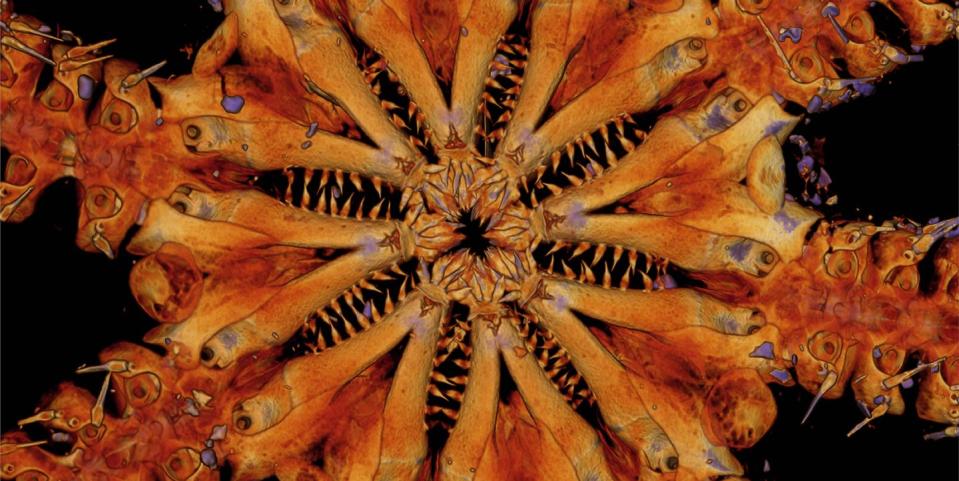This Jurassic Deep Sea Creature Looks Like a Terrifying Starfish with Razor Teeth

Scientists from the French Natural History Museum collected an ancient specimen of brittle star (Ophiojura) in 2011.
Earlier this month, a team of researchers in Australia finished analyzing the creature and published their findings in Proceedings of the Royal Society B.
The odd echinoderm is believed to be the last known survivor of its lineage, and features several sets of sharp teeth and eight arms.
Looking at Ophiojura, a bizarre deep-sea creature with a gnarly set of saw-like teeth, you'd think Halloween came early this year.
By chance, researchers happened upon this ancient genus of brittle star—a distant relative of the starfish—during a 2011 trawling expedition on the Banc Durand seamount off the coast of New Caledonia in the Pacific. But it took 10 years for scientists to analyze the peculiar echinoderm's DNA. Last week, they published their findings in the journal Proceedings of the Royal Society B.
At the helm of those efforts is Tim O'Hara, senior curator of marine invertebrates at Museums Victoria in Melbourne, Australia. In 2015, his taxonomic specialty in Ophiurodea (brittle stars) proved incredibly useful: while sorting through a bucket of brittle stars, the 2011 Ophiojura specimen caught his eye. It had two atypical features, even in the realm of brittle stars: eight arms (most have five) and eight nasty, razor-sharp sets of teeth.
"A microscopic scan revealed bristling rows of sharp teeth lining every jaw, which I reckon are used to snare and shred its prey," O'Hara explains in a blog post for The Conversation, a nonprofit media network that publishes news stories on new academic breakthroughs. He describes Ophiojura as "a totally unique and previously undescribed type of animal."
Ophiojura has endured millions of years of evolution and is the last known survivor of its ancient lineage, which dates back to somewhere between the Jurassic (199.6 million to 145.5 million years ago) and late Triassic (252 to 201 million years ago) eras. It's a similar story to that of the coelacanths, who were thought to be extinct for several million years until a museum curator discovered one entirely by chance in 1938.
O'Hara calls species like Ophiojura—which represent a once-larger pool of related specimens, that over time have evolved into a much smaller group—"paleo-endemics," in lieu of "living fossils," because even if the evolutionary changes have been minuscule over time, they're technically still occurring.
O'Hara hopes that the discovery of this ancient lineage of brittle star will excite the public and academic community enough to justify funding for further taxonomic deep sea research. He's particularly rosy about further inquiry into seamounts (like the one where scientists found Ophiojura), which are usually submerged volcanoes that are millions of years old.
Given that seamounts form in layers of lava and basalt, heaps of ecological history are preserved in the form of fossils, even after the volcano dies and sinks back into the sea. This natural form of record-keeping means that there could be potentially innumerable other species and lineages awaiting discovery—just like Ophiojura.
In fact, O'Hara will be leading a 45-day expedition to study ancient seamounts that largely remain unexplored around the Christmas and Cocos Islands in the Indian Ocean later this summer.
"While our new species is from the southwest Pacific, seamounts occur worldwide and we are just beginning to explore those in other oceans," O'Hara says. "These seamounts are ancient—up to 100 million years old—and almost totally unexplored. We are truly excited at what we may find."
🎥 Now Watch This:
You Might Also Like
